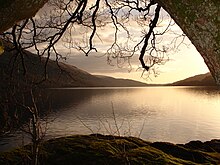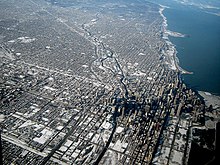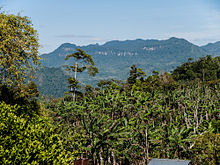Ecosystems
Loch Lomond
in Scotland forms a relatively isolated ecosystem. The fish community
of this lake has remained unchanged over a very long period of time.
[39]
Ecosystems are composed of a variety of
abiotic and
biotic components that function in an interrelated way.
[40]
The structure and composition is determined by various environmental
factors that are interrelated. Variations of these factors will initiate
dynamic modifications to the ecosystem. Some of the more important
components are:
soil, atmosphere, radiation from the
sun, water, and living organisms.
Central to the ecosystem concept is the idea that
living organisms interact with every other element in their local
environment.
Eugene Odum, a founder of ecology, stated: "Any unit that includes all
of the organisms (ie: the "community") in a given area interacting with
the physical environment so that a flow of energy leads to clearly
defined trophic structure, biotic diversity, and material cycles (i.e.:
exchange of materials between living and nonliving parts) within the
system is an ecosystem."
[41] Within the ecosystem, species are connected and dependent upon one another in the
food chain, and exchange energy and
matter between themselves as well as with their environment.
[42] The human ecosystem concept is based on the human/nature
dichotomy and the idea that all species are ecologically dependent on each other, as well as with the abiotic constituents of their
biotope.
[43]
A smaller unit of size is called a
microecosystem. For example, a microsystem can be a stone and all the life under it. A
macroecosystem might involve a whole
ecoregion, with its
drainage basin.
[44]
Wilderness
Wilderness is generally defined as areas that have not been
significantly modified by human activity. Wilderness areas can be found
in preserves, estates, farms, conservation preserves, ranches,
national forests,
national parks, and even in urban areas along rivers, gulches, or otherwise undeveloped areas. Wilderness areas and protected
parks are considered important for the survival of certain
species, ecological studies,
conservation, and solitude. Some nature writers believe wilderness areas are vital for the human spirit and creativity,
[45] and some ecologists consider wilderness areas to be an integral part of the Earth's self-sustaining natural
ecosystem (the
biosphere). They may also preserve historic
genetic traits and that they provide
habitat for wild
flora and
fauna that may be difficult or impossible to recreate in
zoos,
arboretums, or





0 comments:
Post a Comment